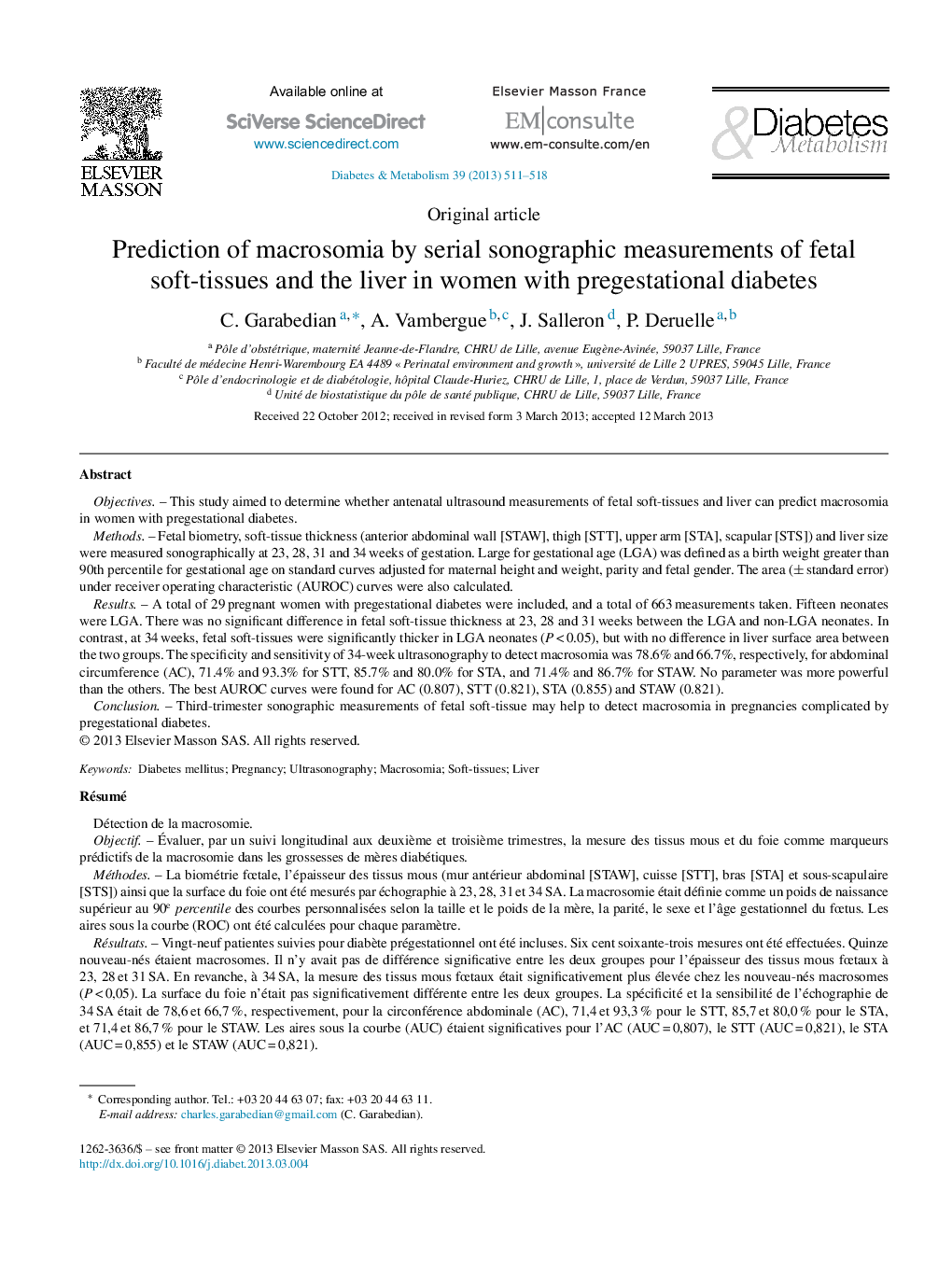| کد مقاله | کد نشریه | سال انتشار | مقاله انگلیسی | نسخه تمام متن |
|---|---|---|---|---|
| 3259626 | 1207581 | 2013 | 8 صفحه PDF | دانلود رایگان |

ObjectivesThis study aimed to determine whether antenatal ultrasound measurements of fetal soft-tissues and liver can predict macrosomia in women with pregestational diabetes.MethodsFetal biometry, soft-tissue thickness (anterior abdominal wall [STAW], thigh [STT], upper arm [STA], scapular [STS]) and liver size were measured sonographically at 23, 28, 31 and 34 weeks of gestation. Large for gestational age (LGA) was defined as a birth weight greater than 90th percentile for gestational age on standard curves adjusted for maternal height and weight, parity and fetal gender. The area (± standard error) under receiver operating characteristic (AUROC) curves were also calculated.ResultsA total of 29 pregnant women with pregestational diabetes were included, and a total of 663 measurements taken. Fifteen neonates were LGA. There was no significant difference in fetal soft-tissue thickness at 23, 28 and 31 weeks between the LGA and non-LGA neonates. In contrast, at 34 weeks, fetal soft-tissues were significantly thicker in LGA neonates (P < 0.05), but with no difference in liver surface area between the two groups. The specificity and sensitivity of 34-week ultrasonography to detect macrosomia was 78.6% and 66.7%, respectively, for abdominal circumference (AC), 71.4% and 93.3% for STT, 85.7% and 80.0% for STA, and 71.4% and 86.7% for STAW. No parameter was more powerful than the others. The best AUROC curves were found for AC (0.807), STT (0.821), STA (0.855) and STAW (0.821).ConclusionThird-trimester sonographic measurements of fetal soft-tissue may help to detect macrosomia in pregnancies complicated by pregestational diabetes.
RésuméObjectifÉvaluer, par un suivi longitudinal aux deuxième et troisième trimestres, la mesure des tissus mous et du foie comme marqueurs prédictifs de la macrosomie dans les grossesses de mères diabétiques.MéthodesLa biométrie fœtale, l’épaisseur des tissus mous (mur antérieur abdominal [STAW], cuisse [STT], bras [STA] et sous-scapulaire [STS]) ainsi que la surface du foie ont été mesurés par échographie à 23, 28, 31 et 34 SA. La macrosomie était définie comme un poids de naissance supérieur au 90epercentile des courbes personnalisées selon la taille et le poids de la mère, la parité, le sexe et l’âge gestationnel du fœtus. Les aires sous la courbe (ROC) ont été calculées pour chaque paramètre.RésultatsVingt-neuf patientes suivies pour diabète prégestationnel ont été incluses. Six cent soixante-trois mesures ont été effectuées. Quinze nouveau-nés étaient macrosomes. Il n’y avait pas de différence significative entre les deux groupes pour l’épaisseur des tissus mous fœtaux à 23, 28 et 31 SA. En revanche, à 34 SA, la mesure des tissus mous fœtaux était significativement plus élevée chez les nouveau-nés macrosomes (P < 0,05). La surface du foie n’était pas significativement différente entre les deux groupes. La spécificité et la sensibilité de l’échographie de 34 SA était de 78,6 et 66,7 %, respectivement, pour la circonférence abdominale (AC), 71,4 et 93,3 % pour le STT, 85,7 et 80,0 % pour le STA, et 71,4 et 86,7 % pour le STAW. Les aires sous la courbe (AUC) étaient significatives pour l’AC (AUC = 0,807), le STT (AUC = 0,821), le STA (AUC = 0,855) et le STAW (AUC = 0,821).ConclusionLes mesures échographiques des tissus mous fœtaux au troisième trimestre apparaissent comme un outil supplémentaire pour la détection de la macrosomie chez les fœtus de mères suivies pour diabète prégestationnel.
Journal: Diabetes & Metabolism - Volume 39, Issue 6, December 2013, Pages 511–518